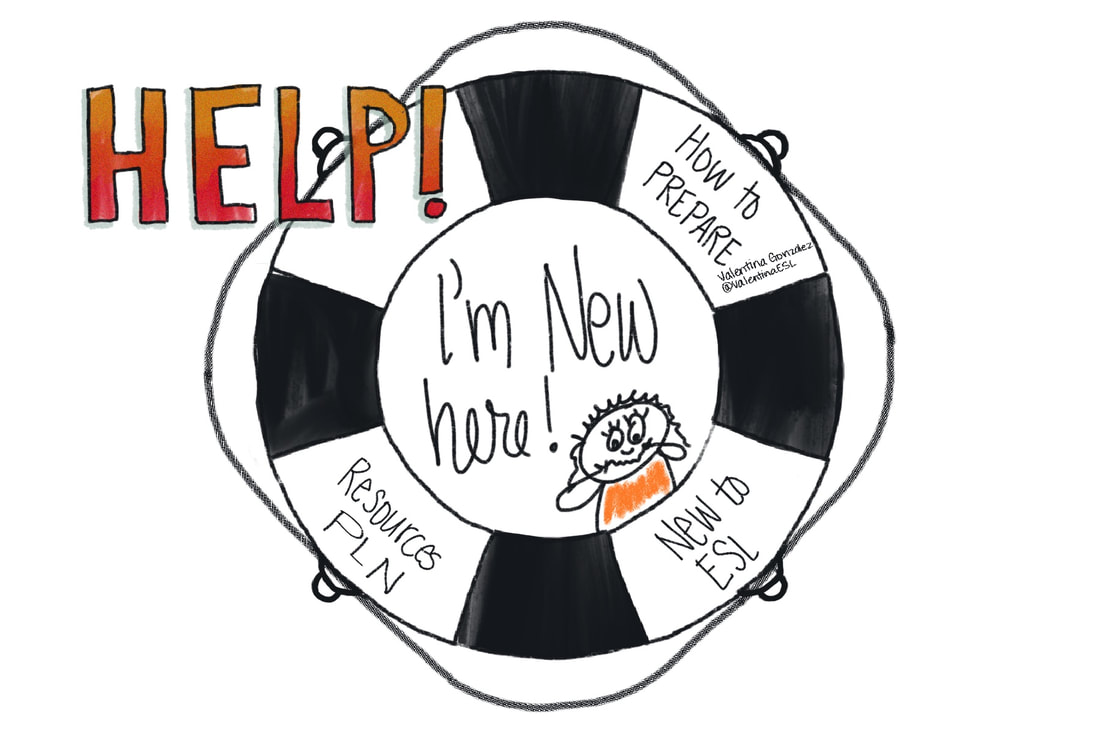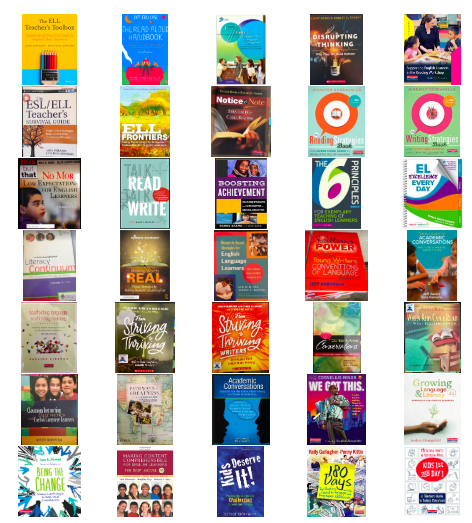6 Things you can do now!First of all, WELCOME! We are glad to have you in our professional learning network. If you are reading this, I want to formally welcome you to a wonderful, passionate group of ESL educators and advocates who will support you along the way. In this article, you will find ideas for professional learning, resources to dig into, leaders in the field, and much more. So you secured an ESL position. And you're wondering...how can I prepare for this job? 1. Get to know your state laws regarding ELLs. Each state follows specific laws regarding how students are screened for services, how parents are notified, and the programs offered for English learners. It will be important for you to know what those are in your state and how your district complies. This will help you advocate for families as they enter your campus. When you attend parent-teacher conferences, staffings, RTI meetings, etc. the knowledge you have will enable you to speak confidently about the rights of English learners. 2. Find out what type of programs and curriculum your school offers for serving English learners. Your campus may offer a bilingual program and an ESL program. It may only offer an ESL program. Some ESL programs are pull out models and other are coteach. There are many that use a combination of both pull out and coteach. They pull out students at earlier levels of English proficiency and coteach in classrooms where students have higher levels of English proficiency. If you are pulling students out for intense small group instruction, you’ll want to know if there is a curriculum you’ll follow. 3. Explore the resources and curriculum that you will be using with students. Basically, take a look at what you have so that you will be familiar with the resources and so that you can start a wish list of your needs. When the school year starts, things will get busy! You won’t have time to explore your resources. Looking at them now will help you when you need just the right picture or game or book on ___. In addition, take a look at the books your school or department have. Think about the demographics (and if you don’t have that yet, that’s something you’ll want to get your hands on). If you begin to notice that your campus is lacking on books that represent the student population, start a wish list of culturally inclusive book. Colorin Colorado has a great list that can help you begin. When funding is available, submit your list! Some teachers try to get culturally inclusive books funded through Donor’s Choose or by asking their PTA/PTO for funds. 4. Build an online bank of resources you’ll have at the tip of your fingers. These are websites and blogs that will help you continue to learn and grow. But most importantly, they are current and offer relevant information regularly. I made a Bookmark folder with all of these on my computer and I constantly add more. Keep in mind, that these are just a starting point!
Books: The ELL Teacher’s Toolbox 6 Principles to Exemplary Teaching of English Learners EL Excellence Every Day 7 Steps to a Language Rich Interactive Classroom (below you will find a link and picture to many of my other favorite EL related professional learning books) Online learning or Virtual learning: These are the top 10 EL Leaders on Twitter who I constantly count on to share high quality resources and ideas (plus 1). They are in no particular order.
Once you follow all these people, look at who they are following and follow some of their followers. You can also join the ELLchat_BkClub and participate with us in reading and discussing books on Twitter. Find out more about the virtual club by clicking here. Popular ELL related hashtags to view and use are: #ELL, #ELLs, #ELLchat, #ELLchat_BKclub, #ESL Feel free to join our FaceBook group called Advocating for ELLs. It's a great place to ask a question, share a success story, learn something new, share information, etc. And VirtuEL is an excellent FREE online PD offered by Tan and Carol. You can log on anytime and view the past presentations. If you like listening to podcasts, I suggest these: Cult of Pedagogy with Jennifer Gonzalez Highest Aspirations with ELLevation Boosting Achievement with Carol Salva 6. Begin building relationships with the teachers you will be working with either in a co-teach setting or otherwise. Some ESL teachers work in co-teach settings going into classrooms. If you will be co-teaching, building a strong, healthy and positive relationship with your partner is paramount. Start by getting to know you partner on a personal level. Then move into logistics of how you will co-teach. What will that look like, feel like, sound like? Who will do what? And when? On the other hand, if you will be pulling students out of classrooms to work in small group settings, it's still important to build rapport with teachers. You will be sharing students with these teachers. Though you won't be in the same instructional space, you will still need to communicate linguistic and academic information about the students. Building a relationship with these teachers will help send the message that we are working as a team. Finally.... I am sure there's more. But I think these 6 things are plenty to begin with. And if you ever need support, reach out to me or any of the people I listed in #5 or on the Advocating FB Page. This community of educators truly cares about helping students and teachers. And one last thing. a piece of advice that my best friend often has to remind me still to this day (and i've been in education over 20 years)...It's a marathon not a sprint. I can't wait to hear about your journey. Valentina Gonzalez It's a marathon not a sprint.
16 Comments
Caryn Rosenbeck
5/27/2019 04:08:38 pm
Thank you! This is just what I needed! I am starting next school year as an ESL teacher. My coworker, Kelly Luedeke, follows you and send me a lot of your Tweets!
Reply
Valentina
9/7/2019 11:19:58 am
How wonderful, Caryn! How's the start of your year going?
Reply
TAN HUYNH
5/28/2019 06:31:24 am
Hi, Valentina.
Reply
Polly
5/28/2019 01:23:11 pm
Thank you!! This is exactly what I needed. I’ll be teaching ESL next year for the first time, in a new district and and after taking a two-year maternity leave. Thank you!! Hvala!!
Reply
Katherine Mingin Fedor
5/30/2019 02:02:08 pm
Valentina,
Reply
Valentina
9/7/2019 11:20:44 am
Thank you for sharing that resource, Katherine. I will look into it!
Reply
MELANIE REYNOLDS
6/2/2019 12:34:08 am
I would like to receive your posts and resources.
Reply
Valentina
9/7/2019 11:21:35 am
Thanks for reading and requesting this, Melanie. I need to get on that. LOL!
Reply
6/5/2019 02:41:33 pm
This is an amazing article! You got the tips, the books, and even the people to follow on Twitter with links to their pages....and some hashtags?!
Reply
Valentina
9/7/2019 11:22:30 am
I am happy to hear that this article was super helpful to you, Beckett! Thank you for the feedback!
Reply
Katie
7/19/2019 12:36:29 pm
Thank you! This was incredibly helpful. I am moving from a fourth grade classroom teacher to a ESL teacher at 3,4,5 elementary school. This was a great resource.
Reply
Valentina
9/7/2019 11:23:37 am
Excellent, Katie! How's your year going so far? I can't wait to hear about your first year as an ESL teacher!! Very exciting but I remember mine. I had ups and downs.
Reply
F Yilmaz
8/25/2019 06:22:10 pm
Thank you for this website! I will begin my ESL teaching journey in two weeks, and found this great site. I appreciate the links and resources you provided--amazing! Thx Thx Thx
Reply
Valentina
9/7/2019 11:24:36 am
I'm happy to hear that this article was helpful to you! Have a wonderful first year! And please stay in touch!
Reply
Tia
1/25/2020 10:47:41 am
Thanks for this article! I just received my ESL certification and hope to start at a K-8 school in the fall. I’ll be checking out all of these resources. What do you wish you knew your first year? My school does not have a curriculum in place... Any suggestions or resources for where to start?
Reply
Your comment will be posted after it is approved.
Leave a Reply. |
Categories
All
|



 RSS Feed
RSS Feed
